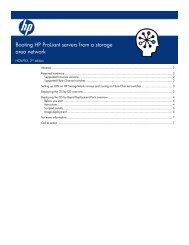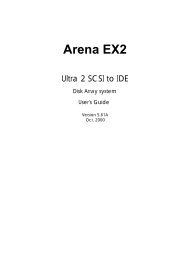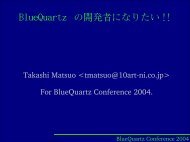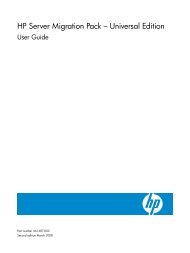- Page 1 and 2: Sausalito Developer’s Guide Beta
- Page 3 and 4: Contents iii Acknowledgements . . .
- Page 5 and 6: Contents v Syntax: PROPERTY . . . .
- Page 7 and 8: Contents vii Usage . . . . . . . .
- Page 9 and 10: Contents ix removeIcon. . . . . . .
- Page 11 and 12: Contents xi The BYE Command. . . .
- Page 13 and 14: Chapter 1 Introducing The Sausalito
- Page 15 and 16: Chapter 1: Introducing The Sausalit
- Page 17 and 18: Chapter 1: Introducing The Sausalit
- Page 19 and 20: Chapter 2 About The Sausalito Archi
- Page 21 and 22: Chapter 2: About The Sausalito Arch
- Page 23 and 24: Chapter 2: About The Sausalito Arch
- Page 25: Chapter 2: About The Sausalito Arch
- Page 29 and 30: Chapter 3 User Interface Chapter Co
- Page 31 and 32: Chapter 3: User Interface 3—3 Bet
- Page 33 and 34: Chapter 3: User Interface 3—5 Bet
- Page 35 and 36: Chapter 3: User Interface 3—7 Bet
- Page 37 and 38: Chapter 3: User Interface 3—9 Bet
- Page 39 and 40: Chapter 3: User Interface 3—11 Be
- Page 41 and 42: Chapter 4 Using i18n and l10n in Sa
- Page 43 and 44: Chapter 4: Using i18n and l10n in S
- Page 45 and 46: Chapter 4: Using i18n and l10n in S
- Page 47 and 48: Chapter 4: Using i18n and l10n in S
- Page 49 and 50: Chapter 4: Using i18n and l10n in S
- Page 51 and 52: Chapter 4: Using i18n and l10n in S
- Page 53 and 54: Chapter 4: Using i18n and l10n in S
- Page 55 and 56: Chapter 4: Using i18n and l10n in S
- Page 57 and 58: Chapter 5 Introducing The Cobalt Co
- Page 59 and 60: Chapter 5: Introducing The Cobalt C
- Page 61 and 62: Chapter 5: Introducing The Cobalt C
- Page 63 and 64: Chapter 5: Introducing The Cobalt C
- Page 65 and 66: Chapter 5: Introducing The Cobalt C
- Page 67 and 68: Chapter 5: Introducing The Cobalt C
- Page 69 and 70: Chapter 5: Introducing The Cobalt C
- Page 71 and 72: Chapter 5: Introducing The Cobalt C
- Page 73 and 74: Chapter 5: Introducing The Cobalt C
- Page 75 and 76: Chapter 5: Introducing The Cobalt C
- Page 77 and 78:
Chapter 5: Introducing The Cobalt C
- Page 79 and 80:
Chapter 5: Introducing The Cobalt C
- Page 81 and 82:
Chapter 5: Introducing The Cobalt C
- Page 83 and 84:
Chapter 5: Introducing The Cobalt C
- Page 85 and 86:
Chapter 5: Introducing The Cobalt C
- Page 87 and 88:
Chapter 5: Introducing The Cobalt C
- Page 89 and 90:
Chapter 5: Introducing The Cobalt C
- Page 91 and 92:
Chapter 5: Introducing The Cobalt C
- Page 93 and 94:
Chapter 5: Introducing The Cobalt C
- Page 95 and 96:
Chapter 5: Introducing The Cobalt C
- Page 97 and 98:
Chapter 5: Introducing The Cobalt C
- Page 99 and 100:
Chapter 5: Introducing The Cobalt C
- Page 101 and 102:
Chapter 5: Introducing The Cobalt C
- Page 103 and 104:
Chapter 5: Introducing The Cobalt C
- Page 105 and 106:
Chapter 6 Making Sausalito-Aware Ap
- Page 107 and 108:
Chapter 6: Making Sausalito-Aware A
- Page 109 and 110:
Chapter 6: Making Sausalito-Aware A
- Page 111 and 112:
Chapter 6: Making Sausalito-Aware A
- Page 113 and 114:
Chapter 6: Making Sausalito-Aware A
- Page 115 and 116:
Chapter 6: Making Sausalito-Aware A
- Page 117 and 118:
Chapter 6: Making Sausalito-Aware A
- Page 119 and 120:
Chapter 6: Making Sausalito-Aware A
- Page 121 and 122:
Chapter 6: Making Sausalito-Aware A
- Page 123 and 124:
Chapter 6: Making Sausalito-Aware A
- Page 125 and 126:
Chapter 6: Making Sausalito-Aware A
- Page 127 and 128:
Chapter 6: Making Sausalito-Aware A
- Page 129 and 130:
Appendix A User Interface Foundatio
- Page 131 and 132:
Appendix A: User Interface Foundati
- Page 133 and 134:
Appendix A: User Interface Foundati
- Page 135 and 136:
Appendix A: User Interface Foundati
- Page 137 and 138:
Appendix A: User Interface Foundati
- Page 139 and 140:
Appendix A: User Interface Foundati
- Page 141 and 142:
Appendix A: User Interface Foundati
- Page 143 and 144:
Appendix A: User Interface Foundati
- Page 145 and 146:
Appendix A: User Interface Foundati
- Page 147 and 148:
Appendix A: User Interface Foundati
- Page 149 and 150:
Appendix A: User Interface Foundati
- Page 151 and 152:
Appendix A: User Interface Foundati
- Page 153 and 154:
Appendix A: User Interface Foundati
- Page 155 and 156:
Appendix A: User Interface Foundati
- Page 157 and 158:
Appendix A: User Interface Foundati
- Page 159 and 160:
Appendix A: User Interface Foundati
- Page 161 and 162:
Appendix A: User Interface Foundati
- Page 163 and 164:
Appendix A: User Interface Foundati
- Page 165 and 166:
Appendix A: User Interface Foundati
- Page 167 and 168:
Appendix A: User Interface Foundati
- Page 169 and 170:
Appendix A: User Interface Foundati
- Page 171 and 172:
Appendix A: User Interface Foundati
- Page 173 and 174:
Appendix A: User Interface Foundati
- Page 175 and 176:
Appendix A: User Interface Foundati
- Page 177 and 178:
Appendix A: User Interface Foundati
- Page 179 and 180:
Appendix A: User Interface Foundati
- Page 181 and 182:
Appendix A: User Interface Foundati
- Page 183 and 184:
Appendix A: User Interface Foundati
- Page 185 and 186:
Appendix A: User Interface Foundati
- Page 187 and 188:
Appendix A: User Interface Foundati
- Page 189 and 190:
Appendix A: User Interface Foundati
- Page 191 and 192:
Appendix A: User Interface Foundati
- Page 193 and 194:
Appendix A: User Interface Foundati
- Page 195 and 196:
Appendix A: User Interface Foundati
- Page 197 and 198:
Appendix A: User Interface Foundati
- Page 199 and 200:
Appendix B Utility Classes ArrayPac
- Page 201 and 202:
Appendix B: Utility Classes B—3 B
- Page 203 and 204:
Appendix B: Utility Classes B—5 B
- Page 205 and 206:
Appendix B: Utility Classes B—7 B
- Page 207 and 208:
Appendix C l About Style Style File
- Page 209 and 210:
Appendix C: About Style C—3 Beta
- Page 211 and 212:
Appendix C: About Style C—5 Beta
- Page 213 and 214:
Appendix C: About Style C—7 Beta
- Page 215 and 216:
Appendix C: About Style C—9 Beta
- Page 217 and 218:
Appendix C: About Style C—11 Beta
- Page 219 and 220:
Appendix C: About Style C—13 Beta
- Page 221 and 222:
Appendix C: About Style C—15 Beta
- Page 223 and 224:
Appendix C: About Style C—17 Beta
- Page 225 and 226:
Appendix C: About Style C—19 Beta
- Page 227 and 228:
Appendix C: About Style C—21 Beta
- Page 229 and 230:
Appendix C: About Style C—23 Beta
- Page 231 and 232:
Appendix C: About Style C—25 Beta
- Page 233 and 234:
Appendix C: About Style C—27 Beta
- Page 235 and 236:
Appendix D Base Data Types Scalar W
- Page 237 and 238:
Appendix D: Base Data Types D—3 B
- Page 239 and 240:
Appendix D: Base Data Types D—5 B
- Page 241 and 242:
Appendix E Cobalt System Configurat
- Page 243 and 244:
Appendix E: Cobalt System Configura
- Page 245 and 246:
Appendix E: Cobalt System Configura
- Page 247 and 248:
Appendix E: Cobalt System Configura
- Page 249 and 250:
Appendix E: Cobalt System Configura
- Page 251 and 252:
Appendix E: Cobalt System Configura
- Page 253 and 254:
Appendix F CCE Class Definitions Ch
- Page 255 and 256:
Appendix F: CCE Class Definitions F
- Page 257 and 258:
Appendix F: CCE Class Definitions F
- Page 259 and 260:
Appendix F: CCE Class Definitions F
- Page 261 and 262:
Index Symbols .pkg file format 6-1
- Page 263 and 264:
event_object( ) 5-42 event_oid( ) 5
- Page 265:
MacAddress A-28 MailListName A-28 M







